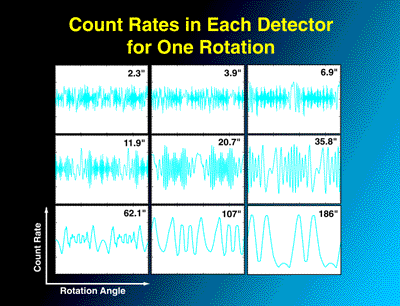|
|
|
Other RHESSI |
|
|
|
|
|
|
|
|
|
|
|
|
Modulation of the Signal:
Modulation means changing the signal so that it varies in a different pattern. Signals for radio and television are modulated electronically and sent over the airwaves to the receiver. Your radio or television receives the signal and decodes the information to give sound or a picture. The HESSI telescope modulates the source mechanically. This modulation is important in giving spatial information. However, the modulation is also important in separating signal from noise. Since X-rays are so penetrating, some may get to the detector unmodulated. They may even come through the back of the detector without passing through the grids. If these noise sources are not modulated, the computer can subtract them from the signal for what they are, noise. So, the grids act as an encryption device to inform the computer what portion of the readout is the real signal. The computer recognizes and analyzes the signal by Fourier Transform Analysis.
X-rays modulated by each of the nine grid pairs give count rates at the detector that have various oscillation patterns. These patterns change with the source angle off the axis of rotation. If the source is at the center of rotation of a grid pair, it has a chance of always shining through a slit or always being blocked by a slat. So, the output signal will be unmodulated. To give information about the position of the source in the sky, the incoming light needs to be modulated by the rotating grid pair. The frequency of the modulation provides the position information. This only happens when the source is off axis.
Data streams from the detectors can be downloaded to the ground and analyzed by computers. The fluctuating intensity of the signal can be plotted as a complex waveform on a graph. The Fourier transform analysis is done when the computer finds simple waveforms that add together to match the the complex waveform from the detector. This analyzed waveform can then be correlated with sky position patterns and photon energy profiles, and time indexed. With that information, the computers can construct image maps of the solar flare in various photon energies.
![]()


